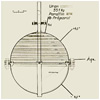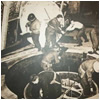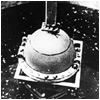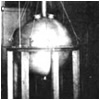|
Dr. Samuel Goudsmit was the head of the
US intelligence mission to Europe codenamed ALSOS, whos objective was to
discover to what extent the Nazis had been working on an atomic weapon. In
his book "ALSOS - The Failure in German Science" (New York, 1947), there
appears a sketch of the zenith of German scientists' achievement in the
field. The same diagram appears in the book authoured by Lt. Leslie Groves,
military chief of the Manhattan Project. Both Goudsmit and Groves stated
that the diagram and photos represent "the German atom bomb".
The bomb was an aluminium sphere, about
the size of a medicine ball, and had a tall chimney. The latter enabled the
radium-beryllium radio-active source to be introduced into the core of the
reaction. Within the sphere was layered alternately natural uranium powder
(551 kilos) and paraffin wax.




The Nobel Prize winner Professor
Heisenberg was looked to as the pioneering genius of Germany's atomic
project. This was outwardly aimed at building a working atomic pile,
a target which had not been reached by the end of hostilities five years
later. The excuse offered was that there was not enough heavy water
available for the final successful experiment. Since Heisenberg's
assistant Dr Karl Wirtz stated in his 1987 book "Im Umkreis der Physik" that
there was easily enough heavy water in aggregate to moderate a nuclear pile
in 1944, and he could not understand the reluctance to go ahead and do so,
our attentions are drawn to the possibility that the heavy water was needed
in another area.
As he admitted, Heisenberg's
experiments B-III and L-IV at Leipzig made calculations regarding the
effectiveness of paraffin wax as a barrier and measured the capture of
neutrons by U-238 uranium material after they had been emitted by the
radioactive source and been slowed by passage through heavy water. Dr.
Flannen, a US physicist, explained in an internet
article that these two experiments could only be explained if the aim was to
design not a reactor, but a bomb.
By 1941 the Germans knew that isotopes of U-238 in
capturing neutrons became transformed into isotopes of plutonium, and
Heisenberg was measuring where most such transformations took place. This
would not be of much interest for reactor technology, but would be vital if
building a bomb. The paraffin wax would have a function as a bomb part in
connection with a technical problem associated with plutonium isotopes.
In June 1942 at Leipzig, Heisenberg placed within an
aluminium sphere about 750 kilos of natural uranium, placed a concentric
sphere of heavy water at its centre, dropped the radioactive source down the
chimney and sat back. Five weeks later there was a disastrous fire and the
experiment was terminated. But - what was this experiment intended to prove?
The United States invested hundreds of millions of
dollars into uranium enrichment plants and plutonium breeder reactors.
Germany, under heavy aerial bombardment and on a tight budget, could never
have competed. What was needed was a nuclear device of small magnitude which
could be mass-produced at small cost.
When an aluminium sphere of natural uranium powder is
left to breed in the manner of Heisenberg's device,
within about two years the plutonium bred by U-238 capturing neutrons
exceeds the figure of 7%. This is the magic figure
for a nuclear explosion of some sort.
If several hundred such spheres were left to breed for
two years in mid-1942, by late 1944 Germany would have had a small arsenal
of little nuclear devices. All that was needed would be some means of
setting them off.
The target was London. If Britain
could be forced out of the war, even in late 1944 there was still a slim
chance of success for Germany. The obvious means of delivering the weapons
on London was the V-2 rocket. The little bombs weighed less than a ton, and
could fit easily into the space for the V-2 warhead. There was no need for
tonnes of conventional explosive to explode the device - the rocket hit the
ground at 3,500 per second. This speed was fast enough to assemble the
plutonium-enriched uranium material into a critical mass. In the
split-second before the reaction collapsed, the resulting blast would be in
the region of 20 tonnes TNT with nuclear fallout. The paraffin wax prevented
the unstable plutonium isotope Pu 240 from reacting too smartly and so ruin
the nuclear reaction.
How long could London have withstood two or three such
rockets fired on London every day? Each crater region
would be unapproachable for years, maybe decades. The effect of the fallout
need not be mentioned. No surprise then, that Lt. Gen
Putt, Deputy Head of United States Air Force Intelligence,
should state shortly after the war that if the invasion of Europe had
been delayed by six months, the course of the war would have been changed,
for Germany had "rocket surprises in store for the whole world in general
and England in particular".
The range of a V-2 was 200 miles. In June 1944,
London was in range from anywhere along the French and Belgian coasts. Six
months after the invasion - December 1944 - the German front line was far
back from this 200 mile point. The Germans had no intermediate rocket to hit
London from Germany - the critical failure of German science. Hence the need
for the Ardennes Campaign to recapture Antwerp which is 200 miles from
London.
Note that although this page is titled
atom bomb, the weapon developped by the Germans could not be called a
nuclear device in the sense of it being an atomic explosive. The Americans
decided in 1944 that the term "nuclear device" or "atom bomb" should not be
applied to any nuclear explosive with an equivalent yield less than
500 tons TNT. The yield of the V-2 warhead would not have exceeded 30 tons
TNT or so. If you have a conventional explosive to scatter radioactive dust,
that weapon is a radiological device. Similarly the weapon
described would have used the effects of meltdown as a localized
radiological weapon.
Originally published under "The
German Atomic Device - The Evidence" by
Geoffrey Brooks at the Axis History
forums. |
![]()